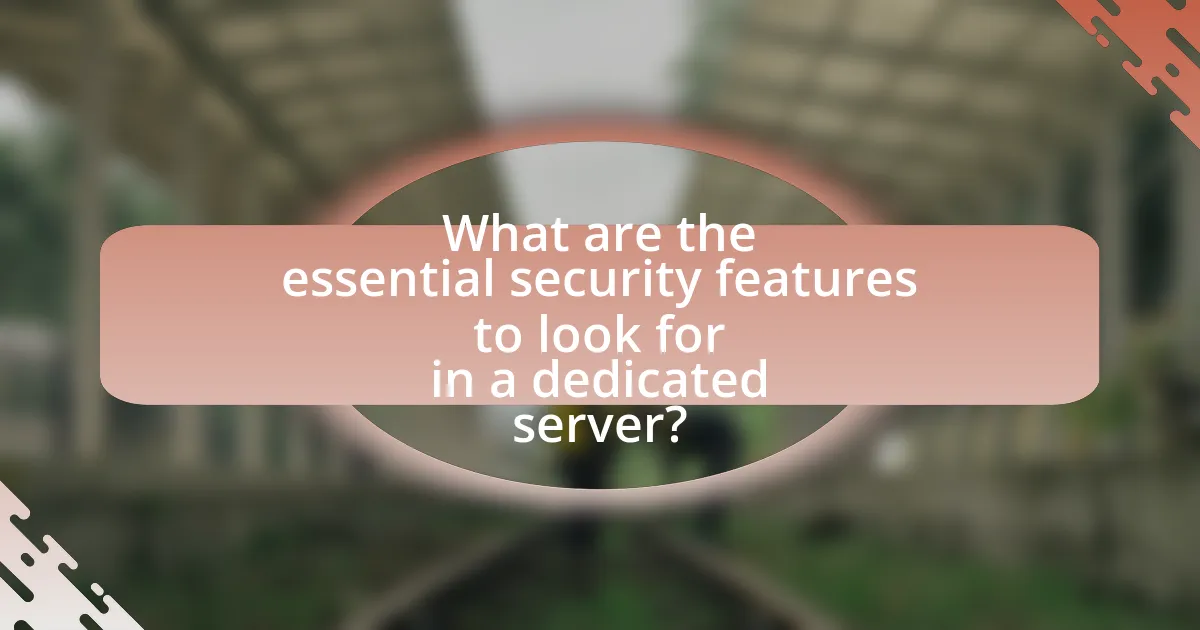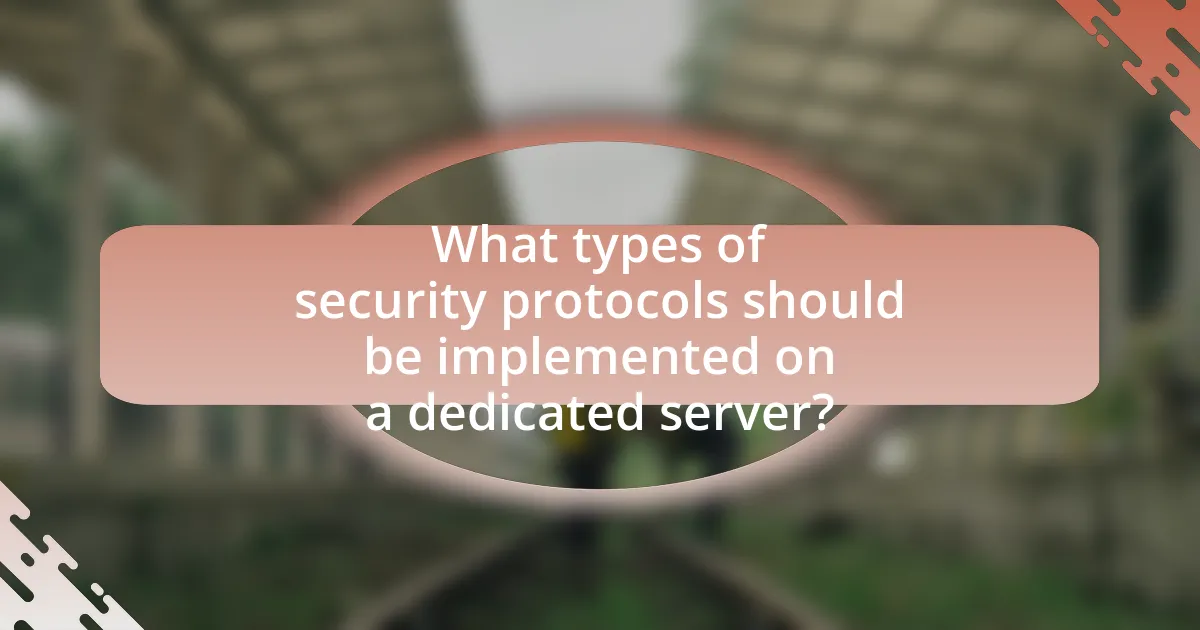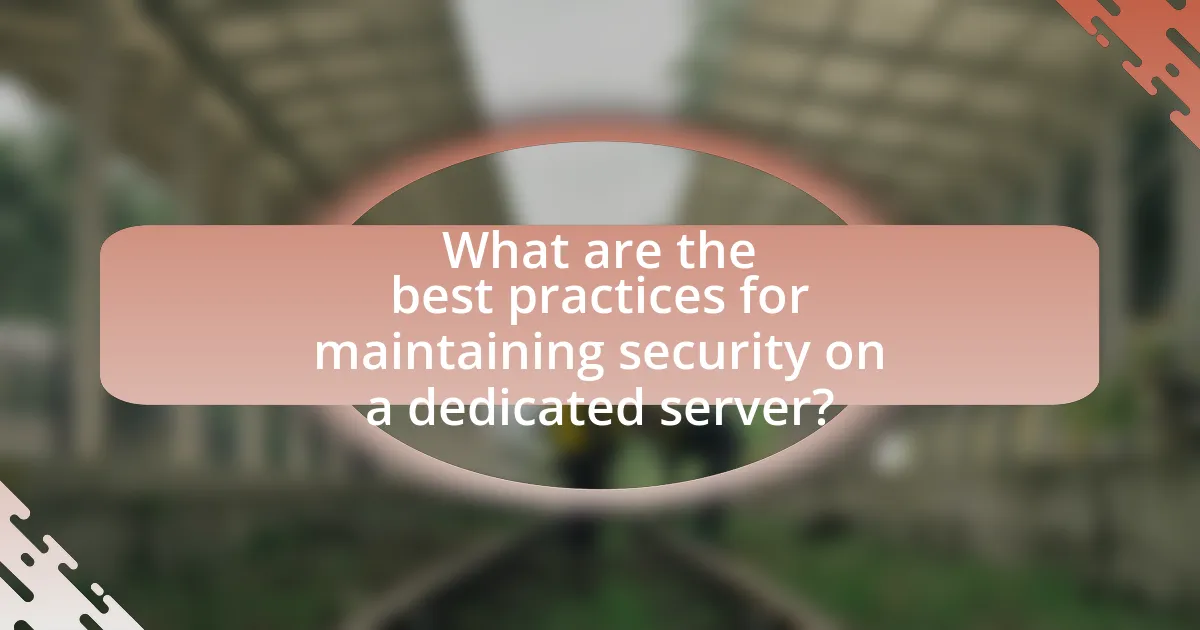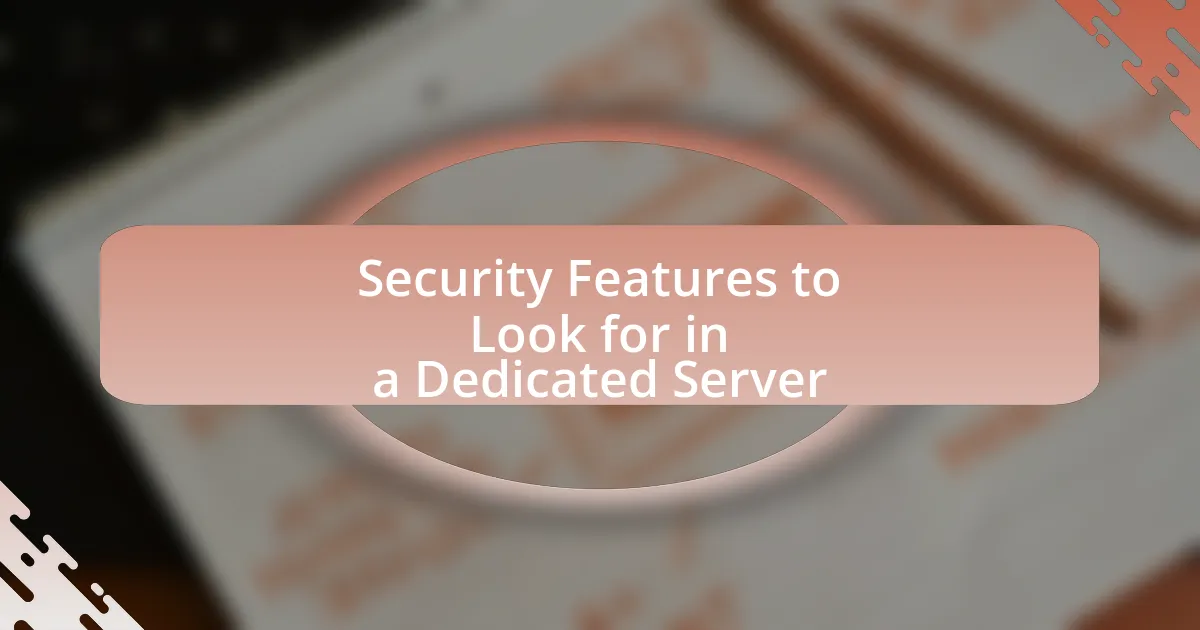The article focuses on essential security features to consider when selecting a dedicated server, emphasizing the importance of robust firewall protection, DDoS mitigation, secure access controls, regular security updates, and data encryption. It explains how these features protect data by creating multiple layers of defense against unauthorized access and cyber threats. Additionally, the article discusses the significance of physical security, access control mechanisms, and the role of encryption in safeguarding sensitive information. Best practices for maintaining server security, including regular updates and monitoring, are also highlighted, along with common security threats and practical tips for enhancing server protection.

What are the essential security features to look for in a dedicated server?
The essential security features to look for in a dedicated server include robust firewall protection, DDoS mitigation, secure access controls, regular security updates, and data encryption. Firewall protection acts as a barrier against unauthorized access, while DDoS mitigation helps prevent service disruptions from malicious traffic. Secure access controls, such as multi-factor authentication, ensure that only authorized users can access sensitive data. Regular security updates are crucial for patching vulnerabilities, and data encryption protects information both at rest and in transit. These features collectively enhance the overall security posture of a dedicated server, safeguarding against various cyber threats.
How do these security features protect your data?
Security features protect your data by implementing multiple layers of defense against unauthorized access and data breaches. These features include firewalls, which monitor and control incoming and outgoing network traffic based on predetermined security rules, and encryption, which secures data by converting it into a coded format that can only be read by authorized users. Additionally, intrusion detection systems (IDS) identify and respond to potential threats in real-time, while regular software updates patch vulnerabilities that could be exploited by attackers. According to a 2021 report by Cybersecurity Ventures, businesses that employ robust security measures can reduce the risk of data breaches by up to 80%, demonstrating the effectiveness of these security features in safeguarding sensitive information.
What role does encryption play in securing data on a dedicated server?
Encryption plays a critical role in securing data on a dedicated server by transforming readable information into an unreadable format, thereby protecting it from unauthorized access. This process ensures that even if data is intercepted or accessed by malicious actors, it remains unintelligible without the appropriate decryption key. For instance, the use of Advanced Encryption Standard (AES) is widely recognized for its effectiveness in safeguarding sensitive information, as it employs a symmetric key algorithm that is difficult to crack. Additionally, encryption not only protects data at rest but also secures data in transit, ensuring that information exchanged between the server and clients remains confidential. This dual-layer protection is essential for maintaining data integrity and compliance with regulations such as GDPR and HIPAA, which mandate stringent data protection measures.
How does firewall protection enhance server security?
Firewall protection enhances server security by acting as a barrier between trusted internal networks and untrusted external networks, effectively monitoring and controlling incoming and outgoing traffic. This proactive defense mechanism prevents unauthorized access and mitigates potential threats, such as malware and hacking attempts. According to a report by Cybersecurity Ventures, organizations that implement firewalls can reduce the risk of data breaches by up to 80%. By filtering traffic based on predetermined security rules, firewalls ensure that only legitimate traffic is allowed, thereby safeguarding sensitive data and maintaining the integrity of server operations.
Why is physical security important for dedicated servers?
Physical security is crucial for dedicated servers because it protects the hardware from unauthorized access, theft, and damage. Dedicated servers often store sensitive data and critical applications, making them prime targets for physical attacks. For instance, a report by the Ponemon Institute indicates that 60% of data breaches involve physical theft or loss of devices. Ensuring robust physical security measures, such as surveillance systems, access controls, and secure server locations, mitigates these risks and safeguards the integrity and availability of the server’s data and services.
What measures ensure the physical security of a dedicated server?
Physical security measures for a dedicated server include controlled access to the server facility, surveillance systems, and environmental controls. Controlled access ensures that only authorized personnel can enter the server room, often implemented through keycards or biometric scanners. Surveillance systems, such as CCTV cameras, monitor the premises continuously, deterring unauthorized access and providing evidence in case of incidents. Environmental controls, including fire suppression systems and climate control, protect the server from physical damage due to fire, flooding, or overheating. These measures collectively enhance the physical security of dedicated servers, safeguarding sensitive data and maintaining operational integrity.
How does location impact the physical security of a dedicated server?
The location of a dedicated server significantly impacts its physical security by determining its exposure to environmental risks, crime rates, and accessibility. For instance, servers located in data centers with robust security measures, such as surveillance and controlled access, are less vulnerable to unauthorized access compared to those in less secure locations. Additionally, geographic areas prone to natural disasters, like floods or earthquakes, pose a higher risk to server integrity. According to the Uptime Institute, data centers in regions with lower crime rates and stable climates report fewer incidents of physical breaches and downtime, reinforcing the importance of location in ensuring the physical security of dedicated servers.

What types of security protocols should be implemented on a dedicated server?
To secure a dedicated server, essential security protocols include Secure Socket Layer (SSL), Transport Layer Security (TLS), Secure Shell (SSH), and Internet Protocol Security (IPsec). SSL and TLS encrypt data transmitted over networks, ensuring confidentiality and integrity, which is critical for protecting sensitive information. SSH provides a secure method for remote server management, allowing encrypted communication and secure file transfers. IPsec secures Internet Protocol communications by authenticating and encrypting each IP packet in a communication session, safeguarding data integrity and confidentiality. Implementing these protocols significantly reduces the risk of data breaches and unauthorized access, thereby enhancing the overall security posture of the dedicated server.
How do access control measures safeguard server resources?
Access control measures safeguard server resources by regulating who can access and interact with those resources. These measures implement authentication protocols, such as passwords and biometric scans, to verify user identities before granting access. Additionally, authorization processes determine the level of access each user has, ensuring that only authorized personnel can perform specific actions on the server. For instance, role-based access control (RBAC) restricts access based on user roles, minimizing the risk of unauthorized data exposure or manipulation. According to a study by the National Institute of Standards and Technology, effective access control can reduce security breaches by up to 80%, highlighting its critical role in protecting server resources.
What are the different types of access control mechanisms?
The different types of access control mechanisms include discretionary access control (DAC), mandatory access control (MAC), role-based access control (RBAC), and attribute-based access control (ABAC). DAC allows users to control access to their own resources, while MAC enforces access policies based on classifications and security levels. RBAC assigns permissions based on user roles within an organization, and ABAC grants access based on attributes of users, resources, and the environment. These mechanisms are essential for managing permissions and ensuring security in dedicated server environments.
How can multi-factor authentication enhance server security?
Multi-factor authentication (MFA) enhances server security by requiring multiple forms of verification before granting access, significantly reducing the risk of unauthorized access. This layered approach means that even if a password is compromised, an attacker would still need additional authentication factors, such as a one-time code sent to a mobile device or biometric verification. According to a study by the Cybersecurity & Infrastructure Security Agency, MFA can block up to 99.9% of automated attacks, demonstrating its effectiveness in protecting sensitive server environments.
What is the significance of regular security updates and patches?
Regular security updates and patches are crucial for maintaining the integrity and security of systems. They address vulnerabilities that could be exploited by attackers, thereby reducing the risk of data breaches and cyberattacks. For instance, according to a report by the Ponemon Institute, 60% of data breaches are linked to unpatched vulnerabilities. By regularly applying updates, organizations can protect sensitive information and ensure compliance with security standards, ultimately safeguarding their reputation and financial stability.
How often should security updates be applied to a dedicated server?
Security updates should be applied to a dedicated server at least once a week. Regular weekly updates help mitigate vulnerabilities that could be exploited by attackers. According to the Cybersecurity & Infrastructure Security Agency (CISA), timely application of security patches is crucial, as many exploits target known vulnerabilities shortly after they are disclosed. Additionally, the National Institute of Standards and Technology (NIST) recommends that organizations prioritize patching based on the severity of vulnerabilities, further emphasizing the importance of frequent updates to maintain server security.
What processes ensure timely application of security patches?
Timely application of security patches is ensured through a combination of automated patch management systems, regular vulnerability assessments, and established update policies. Automated patch management systems streamline the deployment of patches by scheduling updates and monitoring compliance, which reduces the risk of human error and delays. Regular vulnerability assessments identify potential security weaknesses that require immediate attention, allowing organizations to prioritize patching efforts effectively. Established update policies dictate the frequency and process for applying patches, ensuring that critical updates are applied promptly to mitigate risks. These processes collectively enhance the security posture of dedicated servers by minimizing exposure to known vulnerabilities.

What are the best practices for maintaining security on a dedicated server?
The best practices for maintaining security on a dedicated server include regularly updating software, implementing strong password policies, utilizing firewalls, and conducting regular security audits. Regular software updates are crucial as they patch vulnerabilities that could be exploited by attackers. Strong password policies, which involve using complex passwords and changing them frequently, help prevent unauthorized access. Firewalls act as a barrier between the server and potential threats, filtering incoming and outgoing traffic based on predetermined security rules. Regular security audits identify weaknesses in the server’s security posture, allowing for timely remediation. These practices collectively enhance the overall security of a dedicated server, reducing the risk of data breaches and unauthorized access.
How can monitoring and logging improve server security?
Monitoring and logging enhance server security by providing real-time visibility into system activities and enabling the detection of anomalies. Continuous monitoring allows administrators to identify unauthorized access attempts, unusual traffic patterns, and potential vulnerabilities as they occur. Logging creates a detailed record of events, which is crucial for forensic analysis after a security incident. According to a 2020 study by the Ponemon Institute, organizations that implemented effective logging and monitoring practices reduced their breach costs by an average of $1.2 million. This demonstrates that proactive monitoring and comprehensive logging not only help in immediate threat detection but also contribute to long-term security posture improvement.
What tools are available for effective server monitoring?
Effective server monitoring tools include Nagios, Zabbix, and Prometheus. Nagios provides comprehensive monitoring capabilities for servers, networks, and applications, allowing administrators to identify issues before they affect performance. Zabbix offers real-time monitoring and visualization of server metrics, enabling proactive management of server health. Prometheus is designed for reliability and scalability, particularly in cloud-native environments, and it collects metrics from configured targets at specified intervals. These tools are widely recognized in the industry for their effectiveness in ensuring server uptime and performance.
How does logging help in identifying security breaches?
Logging helps in identifying security breaches by providing a detailed record of system activities, which can be analyzed for unusual patterns or unauthorized access attempts. This record includes timestamps, user actions, and system responses, enabling security teams to trace the sequence of events leading up to a breach. For instance, according to the 2021 Verizon Data Breach Investigations Report, 61% of breaches involved credential theft, highlighting the importance of logs in detecting such incidents by revealing failed login attempts or suspicious account activity. By systematically reviewing logs, organizations can quickly identify and respond to potential security threats, thereby enhancing their overall security posture.
What common security threats should dedicated server users be aware of?
Dedicated server users should be aware of common security threats such as DDoS attacks, malware infections, unauthorized access, and data breaches. DDoS attacks can overwhelm server resources, causing downtime; in 2020, 80% of organizations reported experiencing such attacks. Malware infections can compromise server integrity, leading to data loss or theft. Unauthorized access often results from weak passwords or unpatched vulnerabilities, with studies indicating that 81% of data breaches involve weak or stolen passwords. Data breaches can expose sensitive information, impacting both users and businesses significantly. Understanding these threats is crucial for implementing effective security measures.
How can users protect against DDoS attacks on their dedicated servers?
Users can protect against DDoS attacks on their dedicated servers by implementing a combination of traffic filtering, rate limiting, and utilizing DDoS protection services. Traffic filtering allows users to block malicious traffic before it reaches the server, while rate limiting restricts the number of requests a user can make in a given timeframe, effectively mitigating the impact of an attack. Additionally, employing DDoS protection services, such as those offered by Cloudflare or Akamai, can provide advanced threat detection and mitigation strategies. According to a report by the Cybersecurity and Infrastructure Security Agency (CISA), organizations that utilize these protective measures can significantly reduce the risk and impact of DDoS attacks, as they are designed to absorb and redirect malicious traffic away from the targeted server.
What steps can be taken to mitigate the risk of malware infections?
To mitigate the risk of malware infections, implement a multi-layered security approach that includes regular software updates, robust antivirus solutions, and firewalls. Regularly updating software ensures that vulnerabilities are patched, reducing the chances of exploitation by malware. Utilizing reputable antivirus software provides real-time protection and scanning capabilities to detect and remove malware before it can cause harm. Firewalls act as a barrier between the server and potential threats, monitoring incoming and outgoing traffic to block malicious activity. According to the Cybersecurity & Infrastructure Security Agency, keeping systems updated and employing antivirus software are critical steps in maintaining cybersecurity hygiene.
What practical tips can enhance the security of your dedicated server?
To enhance the security of your dedicated server, implement strong password policies and regularly update software. Strong passwords should include a mix of uppercase letters, lowercase letters, numbers, and special characters, making them difficult to guess. Regular software updates patch vulnerabilities; for instance, a report by the Cybersecurity and Infrastructure Security Agency (CISA) indicates that 85% of successful cyberattacks exploit known vulnerabilities that could have been mitigated by timely updates. Additionally, employing a firewall and intrusion detection system (IDS) can monitor and control incoming and outgoing network traffic, further protecting the server from unauthorized access.


